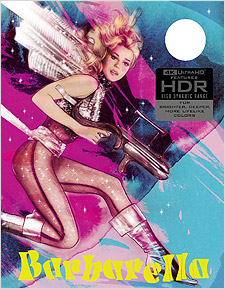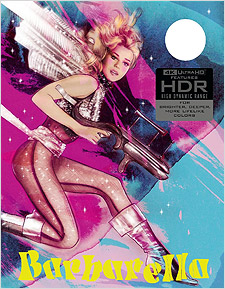Barbarella (4K UHD Review)

Director
Roger VadimRelease Date(s)
1968 (November 28, 2023)Studio(s)
Paramount Pictures (Arrow Video)- Film/Program Grade: B
- Video Grade: A
- Audio Grade: A+
- Extras Grade: A+
Review
“Love.”
Barbarella, or as it was marketed later on its theatrical life, Barbarella: Queen of the Galaxy, left quite the impression when it debuted in the fall of 1968. Premiering right as the new MPAA ratings system was being implemented to replace the antiquated Hays Code, it certainly received its fair share of criticism from many on both sides of the equation, whether they approved of it or not. Jane Fonda had received some recent notice for her appearances in Cat Ballou and Barefoot in the Park before starring in Barbarella for her then-husband Roger Vadim, whom she had worked with previously. The result was a sexy and comedic science fiction romp that didn’t fully connect with US critics at the time. It was praised mostly for its visuals, but not for Jane Fonda’s performance. Although she herself tends to dismiss it as well, her portrayal of the gorgeous “five-star, double-rated Astro-Navigatrix” that travels the uncharted universe in search of lost Earth scientist Durand Durand is so tongue-in-cheek that it’s absolutely protruding.
One of the more interesting aspects of Barbarella is the fact that it strays quite a bit from its source material. In the original comic strips, she’s a free-spirited person who is only too happy to provide sexual pleasure for services rendered, especially to those who save her from certain peril. In the film version, she has a reluctant sexual awakening through those that she meets, explaining that people from Earth have given up traditional lovemaking and only experience it in pill form. In fact, all forms of pleasure come in pills or drinks of some sort, including their dietary needs. They’ve also given up all forms of conflict, meaning that they’re peaceful, and it’s vital that they find Durand Durand before he exposes primitive beings to a Positronic Ray, which could lead to war and devastation. It almost seems like a parody of Gene Roddenberry’s idea of a future society.
In truth, Barbarella has quite a bit of scope, which is partly due to having a larger budget than similar projects, but even so, there’s a quality to it all that’s rarely been replicated. Despite seemingly feeling like a hodge-podge of ideas, it manages to have a narrative through line that’s actually resolved, though it can feel unimportant alongside the other elements. There’s a vast amount of visual stimulation from top to bottom, with a wide array of colorful costumes and sets that subsequently had an influence on the concept of retrofuturism. Amazing visual design is on display, which isn’t limited to standard science fiction ephemera, but the variety of make-up effects and props. They’re often unique and interesting, perhaps more so than many other sci-fi projects of the era, outside of Star Trek.
The biggest hurdle that an audience has to get over when viewing Barbarella is its tone, which constantly wavers. For instance, when Barbarella is captured by the ice children and tortured with mechanical dolls that have snapping metal teeth, it suddenly becomes a horror film of sorts, while in the previous scene she was skiing across the ice led by an alien eel-type of creature with peppy music playing in the background. She’s often confused and unsure of the things around her, making her seem more dense than she is, especially for someone who’s thought of so highly by the president of Earth. One of the highlights is a scene between her and Dildano, played David Hemmings, in which they share lovemaking Earth pills, with hilariously hair-raising, smoke-inducing results. She also takes a liking to a blind angel, Pygar (John Phillip Law), whom she “rewards” for his heroism, giving him the power he needs to fly once again. Let’s also not forget the scene involving the “Ex-sex-sive Machine,” in which she’s subjected to a form of deadly sexual pleasure, or so its creator believes that it will inflict upon her. Needless to say, things don’t go as planned.
The bottom line is that Barbarella is a lot of different things rolled into one. It’s camp, it’s horror, it’s sexy, it’s dramatic, and it’s comedic. Basically, it’s everything, and a lot of audiences and critics don’t know how to ingest films that don’t stick to a consistent tone or idea, which is understandable to a certain degree, but in this case, the mix of tones is the point rather than a byproduct. Many compare it to Danger: Diabolik, in as much as it was also based upon comic books and shared many of the same key players, including John Phillip Law, producer Dino De Laurentiis, and various members of the crew. However, Barbarella continues to stand on its own as a delightfully funny, odd, and somewhat unique piece of genre whimsy.
Barbarella was shot by cinematographer Claude Renoir on 35 mm film using Panavision cameras with anamorphic lenses, finished photochemically, and presented in Technicolor in the aspect ratio of 2.35:1. Arrow Video debuts the film on Ultra HD with a new 4K 16-bit restoration of the original camera negative, graded for High Dynamic Range (HDR10 and Dolby Vision options are included), and presented on a BD-100 disc. Note that sections of an interpositive were also used for damaged areas of the original negative that couldn’t be repaired. Also note that this is the full, uncut version as originally released in 1968, not the 1977 re-release that suffered edits to its content. To say that this is the definitive presentation of Barbarella on optical disc would be an understatement, at best. It’s a gorgeous picture that’s organic and vibrant with a mostly even-keeled layer of grain and a consistently high bitrate that frequently soars over 100Mbps. As this is another release encoded by David Mackenzie of Fidelity in Motion, you’re getting the best that money can buy. Special effects composites and title overlays obviously dip in quality, but it all appears inherent to the presentation and isn’t a fault of the restoration. The color palette offers a wide array of hues on varying planets, costumes, and sets. The HDR grades soak up every last bit of detail, allowing for perfect contrast and deep blacks. It’s a clear, clean, crisp visual feast.
Audio options include English and French 1.0 LPCM, as well as English Dolby Atmos (7.1 Dolby TrueHD compatible). Optional subtitles are provided in English SDH. The English track offers a surprisingly robust soundscape for a single-channel experience, especially when it comes to score and sound effects. The French track is more narrow and the dialogue has occasional sibilance, but it’s noteworthy as Jane Fonda provided her own dubbing for the track. Most curious of all is the newly-minted Atmos track, which is based entirely on the English mono. It doesn’t add to or change anything about the sound design, but merely expands it to the fill up the space. Outside of the Italian track missing in action (noted by Tim Lucas in the audio commentary), there’s little room here for complaint as we’re given plenty of more than suitable options.
The 2-Disc Limited Edition 4K Ultra HD release of Barbarella sits in a black amaray case with a 1080p Blu-ray, six double-sided lobby card reproductions, and a double-sided insert with new artwork by Tula Lotay on one side and the theatrical re-release poster art on the other. Also included is a double-sided poster featuring the same artwork options on either side, and a 120-page booklet containing cast and crew information, the essays Barbarella Psychedela by Anne Bilson, Jean-Claude Forest’s Barbarella by Paul Gravett, Barbarella, Ambassador of Peace and Love by Veronique Bergen, Barbarella, the Unintentional Beacon of Retrofuturism by Elizabeth Castaldo Lunden, a re-creation of the 1968 British press book, restoration details, and a set of production credits. Everything is housed in sturdy cardboard packaging featuring more new artwork by Tula Lotay. The following extras are included on each disc:
DISC ONE: FILM (UHD)
- Audio Commentary by Tim Lucas
- Isolated Score Audio Track
- Alternative Opening Credits (UHD w/HDR – 2:21)
- Alternative Closing Credits (UHD w/HDR – 1:16)
DISC TWO: EXTRAS (BD)
- Another Girl, Another Planet: Glenn Kenny on Barbarella (HD – 23:03)
- Barbarella Forever! (Upscaled SD and HD – 14:54)
- Love: Tim Lucas and Stephen R. Bissette on Barbarella (HD – 113:20)
- Dress to Kill: Elizabeth Castaldo Lundén on Barbarella (HD – 31:30)
- Framing for Claude: An Interview with Roberto Girometti (HD – 17:12)
- Tognazzi on Tognazzi: An Interview with Ricky Tognazzi (HD – 21:56)
- An Angel’s Body Double: An Interview with Fabio Testi (HD – 24:26)
- Dino and Barbarella: A Video Essay by Eugenio Ercolani (HD – 14:27)
- Promotional Material:
- Trailer (HD – 3:21)
- TV Spot (Upscaled SD – :55)
- Radio Spots (HD – 3 in all – 2:55)
- Image Gallery (HD – 84 in all)
Tim Lucas provides another entertaining and illuminating audio commentary, delving into the era that Barbarella was made and how those outside forces did and did not influence it. He compares the film to the original comic strip and analyzes the various differences between the soundtracks, including key differences in the Italian audio, which is not included with this release. He delves into differences from the source material and the careers of those involved. As always with his commentaries, it’s another essential listen. Next is an isolated score audio track, presented in mono LPCM, and a set of alternate opening and closing credits taken from the 1977 PG-rated re-release.
Another Girl, Another Planet features film critic and journalist Glenn Kenny, which is meant to serve as an introduction to the film, but he goes into far more detail than was required of him, which isn’t a bad thing. Barbarella Forever! showcases random pieces of behind-the-scenes footage shot during the making of the film by Paul Joyce. Love features Tim Lucas again, this time joined by comic book artist Stephen R. Bissette, for an on-camera (Skype/Zoom) chat about the history of Barbarella, other adult-oriented books & comics of the era and beyond, whether or not censorship played a role in the film’s content, and what Barbarella may have influenced in its wake, among many other topics.
Dress to Kill offers an interview with fashion and film scholar Elizabeth Castaldo Lundén, who discusses the career of costume designer Jacques Fonteray, his work for the film, and how it impacted retrofuturistic fashion and design. She also talks about scenes cut from the film due to censorship and the alternate costumes from those scenes. Framing for Claude features an interview with camera operator Roberto Girometti about his career, specifically working with cinematographer Claude Renoir. Tognazzi on Tognazzi speaks to actor and director Ricky Tognazzi about his father Ugo Tognazzi, who appears in the film as the ice planet inhabitant Mark Hand. An Angel’s Body Double talks to actor Fabio Testi about his work as a stuntman and body double for John Phillip Law. Dino and Barbarella is a video essay by Eugenio Ercolani about producer Dino De Laurentiis and the part he played in bringing Barbarella to the screen. The rest of the extras include the film’s US trailer, a TV spot, 3 radio spots, and an Image Gallery containing 84 behind-the-scenes photos, promotional photos, and other materials.
Another outstanding release by Arrow Video, Barbarella shines on 4K UHD, and it’s bound to be on many year-end best of lists. With an outstanding presentation and top of the line bonus materials, it comes highly recommended.
“Love.”
- Tim Salmons
(You can follow Tim on social media at these links: Twitter and Facebook. And be sure to subscribe to his YouTube channel here.)

